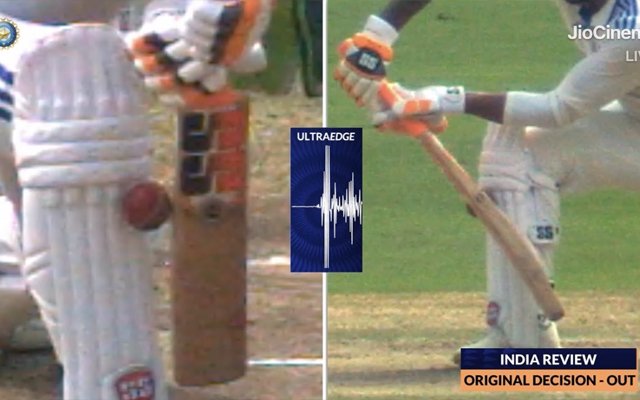IND vs ENG 2024: What does the MCC law say on Ravindra Jadeja's controversial LBW decision?
Ravindra Jadeja was dismissed LBW for 87 in India's first innings of the Hyderabad Test against England.
3 Min Read


India and England are currently involved in the first Test match of their five-match series. On Day 3 of the ongoing Test, at the Rajiv Gandhi International Stadium in Hyderabad, the cricket fraternity witnessed a controversial moment as Ravindra Jadeja was adjudged LBW for 87.
India started Day 3 at 421/7, with Jadeja batting on 81 with Axar Patel. The former added six runs to his score before being adjudged LBW by on-field umpire Chris Gaffaney off the bowling of Joe Root. The incident happened off the third ball of the 120th over. Root bowled from round the wicket and got the ball to come back into the left-handed batter. Jadeja came out on the front foot and tried to defend. However, the inward movement meant that the ball thudded onto his front pad.
As the England players went up in an appeal, Gaffaney raised his finger. Jadeja wasn't too convinced and he went on to challenge the call. Marais Erasmus, the third umpire, watched multiple replays but could not determine whether the ball had hit the pad first or took the inside edge before hitting the pads. The ball seemed to have gotten trapped for a brief moment between the inside edge of Jadeja's bat and his front pad.
"I can't determine if it's bat first," a puzzled Erasmus said before going through with the LBW check. The ball-tracking showed that it was umpire's call on impact as well as on the question of hitting the stumps. Jadeja had to take the long walk back, just 13 runs short of what could have been a magnificent century, as Erasmus asked Gaffaney to stick to his original decision.
The Root cause of English smiles 😃 on Day 3! 🔥
— JioCinema (@JioCinema) January 27, 2024
Keep watching LIVE action from the #INDvENG 1st Test on #JioCinema, #Sports18 & #ColorsCineplex. 👈#JioCinemaSports #BazBowled #IDFCFirstBankTestSeries pic.twitter.com/46eaaYHB64
Unlucky Ravindra Jadeja....!!!!
— Johns. (@CricCrazyJohns) January 27, 2024
- He dismissed for 87, missed a well deserving hundred. pic.twitter.com/Lq25yUmgoX
Here's what MCC Law says:
The striker is out LBW if all the circumstances set out in 36.1.1 to 36.1.5 apply.
36.1.1 The bowler delivers a ball, not being a No ball
36.1.2 the ball, if it is not intercepted full-pitch, pitches in line between wicket and wicket or on the off side of the striker’s wicket
36.1.3 the ball not having previously touched his/her bat, the striker intercepts the ball, either full-pitch or after pitching, with any part of his/her person
36.1.4 the point of impact, even if above the level of the bails, either is between wicket and wicket or if the striker has made no genuine attempt to play the ball with the bat, is between wicket and wicket or outside the line of the off stump.
36.1.5 but for the interception, the ball would have hit the wicket.
36.2 Interception of the ball
36.2.1 In assessing points in 36.1.3, 36.1.4 and 36.1.5, only the first interception is to be considered.
36.2.2 In assessing point 36.1.3, if the ball makes contact with the striker’s person and bat simultaneously, this shall be considered as the ball having first touched the bat.
36.2.3 In assessing point 36.1.5, it is to be assumed that the path of the ball before interception would have continued after interception, irrespective of whether the ball might have pitched subsequently or not.
36.3 Off side of wicket
The off side of the striker’s wicket shall be determined by the striker’s batting position at the moment the ball comes into play for that delivery.
In Jadeja's case, 36.2.2 is very crucial and Jadeja can consider himself unlucky to be dismissed despite the impression that the ball had hit the bat and pad simultaneously.
Download Our App